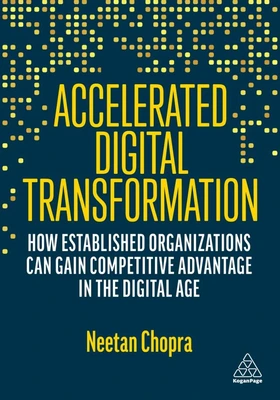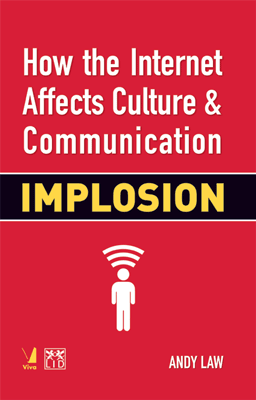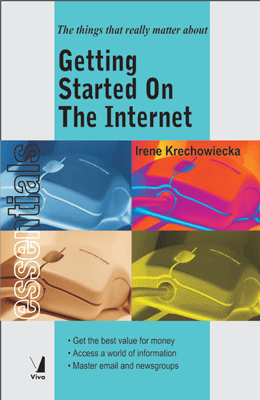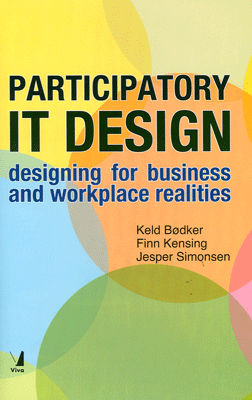Strategic Planning in Information Technology, 2/e
Strategic Planning in Information Technology, 2/e
₹895.50 ₹995.00 Save: ₹99.50 (10%)
Go to cartISBN: 9788130928210
Bind: Paperback
Year: 2015
Pages: 388
Size: 5.5 x 8.5 Inch
Publisher: Viva Books Originals
Sales Territory: Worldwide
Reviews:
Based on the success of the first edition of this book Dinkar has done further research on strategic planning in information technology and has concluded, on the basis of regression analysis and data envelopment analysis, that manpower recruited and trained well is a key asset for success of IT organisations. While this is an obvious conclusion, it is now backed by solid research and analysis. Dinkar has also predicted that some technologies and software options will grow rapidly in the future viz. data warehousing, data mining, artificial intelligence, ERP and E-Commerce. This is already beginning to happen in India.
B. Muthuraman
Vice Chairman,Tata Steel
Description:
The publication of the first edition of Strategic Planning in lnformation Technology - and readers? response to it - made it clear that some important issues had not been dealt with adequately. These have been added in this edition as a result of further research. Opinions of thinkers in this field have been considered and commented upon. In addition, data from firms - both in lndia and the US - have been considered and analysed to prove the importance of manpower in profitability. For this, advanced statistical analysis have been utilised to prove the importance of manpower in the lnformation Technology industry.
Contents:
Chapter 1: INTRODUCTION TO STRATEGY, STRATEGIC PLANNING AND INFORMATION TECHNOLOGY • What is Strategy? • Strategy in War • The Objective • Materials • Machines • Money • Logistics • Men • Strategy in Business • The Objective • Materials • Machines • Money • Logistics • Men • Strategy: A Historical Perspective • Information Technology: A Tool • The Role of Information Technology in Tata Steel: An Example • Summarisation of Content
Chapter 2: CONCEPTS OF STRATEGIC PLANNING • The Corporate Strategic Plan • Strategic Analysis • The Environment in which the Organisation Operates • The Resources Available to the Organisation • Value Chain Analysis • The Resource Audit • Resource Utilisation • Control of Resources • Other Analytical Methods • Assessing the Balance • Expectations and Objectives of Different Groups from the Organisation • Identification of Key Issues • Human Expectations • The Human Factor • The Organisation's Environment and Culture • Objectives • Strategic Options • Implementation of the Selected Strategy • Implementation of the Plan • Notes
Chapter 3: STRATEGIC PLANNING IN INFORMATION TECHNOLOGY • The Strategic Plan • Strategic Planning in Information Technology • Strategic Analysis • The Environment in which the Organisation Operates • The Operating Environment of the Organisation • Resources • Business Applications of Strategic Planning • The Information Technology Organisation • Value Chain of the Information Technology Organisation • Generic List of Information Technology Activities • Examples of Applications • Hardware and Software Issues • Command and Control Centre • Classification of Activities • Classification of Support Activities • Requirements of Domain Specialists • Second Example • Training • Conclusions • Notes
Chapter 4: THE VALUE CHAIN IN INFORMATION TECHNOLOGY • The Information Technology Organisation • The Danger Signals • Internal Signals • External Signals • The Corporate Strategic Plan • Value Chain in the Information Technology Strategic Plan • Structure of Value Chain in Information Technology • Primary Activities in an Information Technology Organisation • Inbound Logistics • Operations • Outbound Logistics • Marketing and Sales • Internal Logistics • Services • Support Activities in an Information Technology Organisation • Procurement • Technology Development • Human Resource Management • Firm Infrastructure • Analysis of the Primary and Support Activities • The Role of the Information Technology Department • Problem Awareness • Problem Diagnosis • Development of Solutions • Selection of a Solution • Implementation of the Solution • Other Issues • Identification of the Tools of Analysis in Primary Activities • Data Acquisition • System Development and Implementation • Delivery Mechanism • Promotion • Data Movement • Services • Identification of the Tools of Analysis in Support Activities • Procurement • Technology Development • Human Resource Management • Firm Infrastructure • Notes
Chapter 5: TECHNOLOGICAL ISSUES: RECENT DEVELOPMENTS • Technological Changes Independent of Strategy • Technology and Business Change • Computer Architecture Issues: RISC Versus CISC • Data Warehousing • Data Mining • Use of Artificial Intelligence • Neural Networks • Fuzzy Logic • Expert Systems • Mainframe Versus Distributed Systems • Transforming Legacy Systems • Notes
Chapter 6: TECHNOLOGICAL ISSUES: COMMUNICATIONS • Mathematics for Data Communication • Fourier Series • Bandwidth Limitations • Transmission Media • Varieties of Transmission Media • Magnetic Media • Twisted Pair • Shielded Twisted Pair • Baseband Coaxial Cable • Broadband Coaxial Cable • Fibre Optics • IEEE Standards • Modes of Communications • Wireless Communications • Radio Transmission • Microwave Transmission • Telephone Communications • Modems and Interfaces • Multiplexing • Switching • Circuit Switching • Packet Switching • Types of Telephone Communications • Narrowband ISDN • ATM • Broadband ISDN • SMDS • Telephones: Other Issues • Satellite Communications • VSAT • TDM/TDMA • DAMA • Selecting a Means of Communication: An Example • Notes
Chapter 7: TECHNOLOGICAL ISSUES: NETWORKING • Introduction • Origin and Growth of Networking • Network Hardware • Broadcast Networks • Point-to-Point Networks • Local Area Networks • IEEE Standards for LANs • Switched LAN • Token Bus (IEEE 802.4) • Token Ring (IEEE 802.5) • Comparison between 802.3, 802.4 and 802.5 Standards • Metropolitan Area Networks • Wide Area Networks • Internets • Network Soft ware • The Layer Cake • Physical Layer • Data Link Layer • Network Layer • Transport Layer • Session Layer • Presentation Layer • Application Layer • Data Transmission • Other Reference Models • Protocols • Transmission Control Protocol • Internet Protocol • Sample Networks • Novell Netware • ARPANET • NSFNET • Network Security • Security of Data and Files in the Network • Security of Messages • Security from Outside Interference • Secrecy • Integrity Control • Authentication • Virtual Private Networks (VPN) • Notes
Chapter 8: THE INTERNET • Internet: A Historical Perspective • The World Wide Web • URL • Domain • IP Addresses • Search Engines • E-Mail • Advertising and Entertainment • Electronic Commerce • Guiding Principles for Electronic Commerce • Issues • Electronic Payment Systems • Legal Issues • Uniform Commercial Code? for Electronic Commerce • Protection of Intellectual Property Rights • Copyrights • Security • Market Access Issues • Telecommunications Infrastructure and Information Technology • File Transfers • News • Intranets • The Internal Web • Documents • Electronic Resources • Interactive Communication • The External Web (Extranet) • Sales and Marketing Data • Customer Support • Supplier/Dealer/Sales Support • Employee Recruiting • Evaluating External Web Usage • Understanding Web Technology • URLs and External Files • Prerequisites for Adopting the New Technology • Implementing an Intranet • Notes
Chapter 9: OPERATING SYSTEMS AND DATABASES • Functions Performed by Operating Systems • Memory Management • Virtual Memory • Paging • Segmentation • File Systems • File Systems and Attributes • Processes • Input/Output Handling • Resolving Deadlocks • Distributed Operating Systems • Databases • Evolution of Databases • Distributed Database • Relational Databases • Notes
Chapter 10: ENTERPRISE RESOURCE PLANNING • Software: The Heart of Information Systems • Enterprise Resource Planning • Development of Enterprise Resource Planning • Benefits of Using Enterprise Resource Planning • Better Utilisation of Resources • Greater Customer Satisfaction • Lower Inventory Holding Cost • Reduced Cycle Time • Increased Flexibility • Overall Cost Reduction • Improved Product Quality • Better and Quicker Planning • Improved Organisational Image • More Informed and Accurate Decision Making • ERP Implementation • Selection of an ERP Package • Issues Concerning Implementation • The Changing Face of Enterprise Resource • Planning Systems • Notes
Chapter 11: THE STRATEGIC VALUE OF MANPOWER • Resources • Hypothesis Concerning Manpower • Selection of IT Companies • Scope of the Study and the Procedures Adopted • Regression Analysis • Data Envelopment Analysis • Efficiency Ratio for ACC • Efficiency Ratio for ICICI • Efficiency Ratio for Ranbaxy • Efficiency Ratio for Siemens • Efficiency Ratio for State Bank of India • Efficiency Ratio for Steel Authority of India • Efficiency Ratio for Tata Motors • Efficiency Ratio for Tata Steel • Efficiency Ratio for Bank of America • Efficiency Ratio for Boeing • Efficiency Ratio for Pfizer • Efficiency Ratio for Proctor and Gamble • Efficiency Ratio for Walmart • Selection of Core "IT" Companies • Efficiency Ratio for HCL • Efficiency Ratio for Infosys • Efficiency Ratio for TCS • Efficiency Ratio for WIPRO • Efficiency Ratio for Apple • Efficiency Ratio for CISCO • Efficiency Ratio for DELL • Efficiency Ratio for Google • Efficiency Ratio for Microsoft • Efficiency Ratio for ORACLE • Rank-Sum-Test • Analysis Reports for Infosys • Regression • Notes • Variables Entered/Removed • Model Summary • Anova • Coefficients • Curve Fit • Notes • Model Description • Case Processing Summary • Variable Processing Summary • Model Summary and Parameter Estimates • Regression • Notes • Variables Entered/Removed • Model Summary
Chapter 12: CONCLUSIONS • Strategic Planning in Information Technology: An Overview • The Role of Concepts in Strategic Planning • Technology and Manpower???The Two Driving Forces • Non Technical Issues • The Future of Strategic Planning in Information Technology • Note
About the Author:
Having watched the development of lnformation Technology almost from its infancy to its present state of well-being, it was natural for Dr Dinkar to look at the areas that make this industry successful. Dinkar worked for a number of years for Tata Steel, which enabled him to study in the US and specialise in Computer Science. This stint was followed by working with Administrative Staff College of lndia as a consultant and teacher. A short period as an independent consultant followed before the next two teaching assignments and working as the Chief lnformation Officer with SVC Supertech.
The teaching assignments were with the Asia Pacific Institute of Management and later with Bengal College of Engineering and Technology. These satisfied his penchant for teaching, consultancy and research and permitted him to analyse the methods and reasons that these companies continue their profitability drive. Having straddled the three worlds of industry, business and academics permits him to concentrate on how to emerge with solutions that take the best from each sphere and avoid the worst. Dinkar's suggestions can be best utilised in recruitment of suitable candidates where academic capabilities need not be the best criteria, but capability and retentivity may be the optimum criteria.





